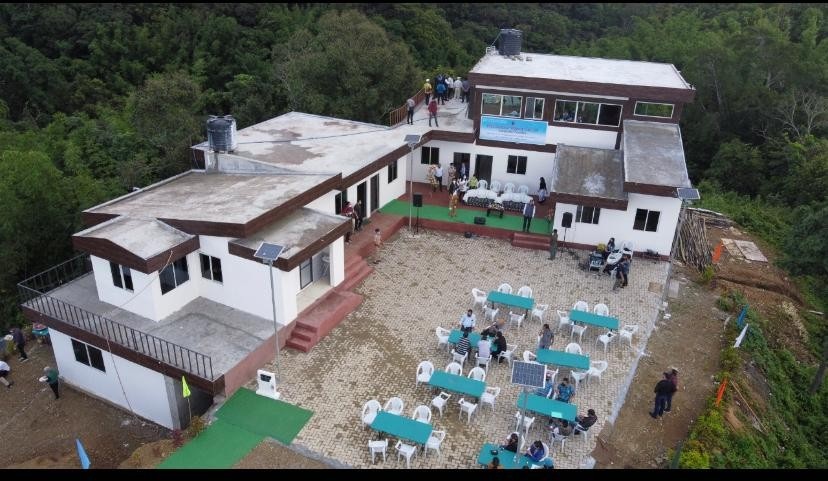The impact of concrete structures on hilly terrains
Construction of a home on a hilly terrain can be a huge challenge when compared to the methodologies used in plains. A completely different topography, climatic conditions and geological challenges, the architects taking up projects in the hills have to take special measures to give the building the required structural strength.
Light Gauge Steel is an ecological, sustainable and smart choice as opposed to an RCC structure on hilly terrains. Here’s why –
CONSTRUCTION ERRORS –
Errors made during construction can include adding improper amounts of water to the concrete mix, inadequate consolidation, and improper curing can cause distress and deterioration of the concrete. Construction errors can lead to problems such as scaling and cracking. Honeycombing and bugholes can be observed after construction.
However, with an alternative technology such as Light Gauge Steel Framing there is no room for error as all the steel structures are built in factory-canceled settings and all steel parts are leveled and labeled to avoid any confusion.
DISINTEGRATION AND SCALING –
Disintegration can be described as the deterioration of the concrete into small fragments and individual aggregates. Scaling is a milder form of disintegration where the surface mortar flakes off. Large areas of crumbling (rotten) concrete, areas of deterioration which are more than about 3 to 4 inches deep (depending on the wall/slab thickness), and exposed rebar indicate serious concrete deterioration. If not repaired, this type of concrete deterioration may lead to structural instability of the concrete structure.
With an alternative technology such as Light Gauge Steel Framing uses galvanized steel sheets used in building structures that offer excellent corrosion, resistance and durability.
CRACKS –
Surface cracks can be caused by freeze-thaw cycles, poor construction practices, and alkali-aggregate reactivity.
Structural cracks in the concrete are usually larger than 0.25 inch in width. They extend deeper into the concrete and may extend all the way through a wall, slab, or other structural member. Structural cracks are often caused by settlement of the fill material supporting the concrete structure, or by loss of the fill support due to erosion. The structural cracks may worsen in severity due to the forces of weathering.
With LGSF, by using factory built parts, the appearence of cracks and the maintenance is negligible.
EROSION –
Erosion due to abrasion results in a worn concrete surface. It is caused by the rubbing and grinding of aggregate or other debris on the concrete surface of a spillway channel or stilling basin. Minor erosion is not a problem but severe erosion can jeopardize the structural integrity of the concrete.
LGSF will not pose this issue as it is a lightweight material and the requirement of a foundation is light. The depth of excavation isn’t too deep either.
ENERGY CONSUMPTION –
Energy consumption is the biggest environmental concern with cement
and concrete production.
Cement production is one of the most energy intensive of all industrial manufacturing process. Including direct fuel use for mining and transporting raw materials, cement production takes about 1,758 kWh for every tonne of cement.
When compared with conventional system of construction LGSF requires up to 68% of minus energy in advanced construction.
The filling that is being used in fabrication of walls, roofs and floors constitute of ozone friendly materials that doesn’t damage nature and its resources.
CO² EMISSIONS –
There are two very different sources of carbon dioxide emissions during
cement production.
Combustion of fossil fuels to operate the rotary kiln is the largest source: approximately
3/4 t of CO2 per ton of cement. The chemical process of calcining limestone into lime in the cement kiln also produces CO2. Combining these two sources, for every ton of cement produced, 1.25 t of CO2 is released into the atmosphere.
Worldwide, cement production now accounts for more than 1.6 × 109 t of CO2 emissions from all human activities.
LGSF offers a considerable reduction in production of onsite waste material, and up to 20% reduction in embodied carbon in building a structure. It requires 65% lesser materials than a traditional structure. Besides, it uses 48% lesser fresh water and reduces greenhouse gas emissions by up to 53%.
WATER POLLUTION –
Another environmental issue with cement and concrete production is
water pollution. At the batch plant, wash water from equipment cleaning is often
discharged into setting ponds where the solids can settled out.
Some returned concrete also gets put into settling ponds to wash off and recover the aggregate.
LGSF is a dry construction method which requires no water, so no wastage or contamination of water on-site. All the products we use are made out of dry components and hence dont need water.
SOLID WASTE –
One cannot overlook the fact that concrete is the most visible component of construction and demolition waste.
It is estimated that the RCC industry in India generates about 10-12 million tons of solid waste annually.
LGSF not only condense waste but significantly reduces waste disposal and trim down cost. In light gauge steel framing frame apparatus are being manufacture in respect of accurate provision which in turn shrinks the amount of surplus waste materials. LGSF components can be supplied to precise size and length, abolishing cutting and trimming and hence dipping any kind of wastages.
HEALTH CONCERNS –
A number of chemicals are now commonly added to concrete to control setting time, plasticity, pumpability, water content, freeze–thaw resistance, strength, and colour. Workability agents or superplasticizers can include such chemicals as sulfonated melamine–formaldehyde and sulphonated napthalene formaldehyde
condensates.
Concrete floors and walls can cause moisture problems and lead to mold and mildew growth, which cause significant health, which cause significant health problems in certain individuals.
Steel is an inorganic material pre-coated with Zinc/Galvalume alloy, thus making them resistant to termites, rust and insects. It is, therefore, not susceptible to degradation, unlike timber and metals that require pest control or anti-termite treatment now and then.
Since steel does not require treatment, we save our health and the environment from contamination by avoiding chlordane, a chemical commonly used in pesticides to kill termites. Chlordane poses a health hazard and damages indoor air quality.
For more, get in touch with us at work@stratus-steel.com or call +91 9156551673.

